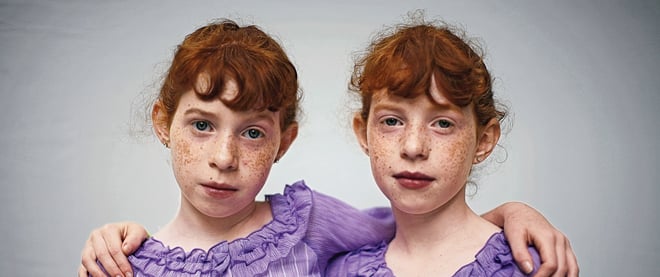Oh, brother: Barbara Amiel on siblings
In praise of (sometimes trying) family ties, bittersweet love and infuriating stubbornness
Jason Reed/Reuters
Share

Having brothers or sisters has been a fact of life for generations, but not necessarily for much longer. The number of children per family in Canada is rapidly decreasing, and almost half of today’s Canadian families have only one child. Siblings are potentially the longest relationship human beings have—longer than parents and predating spouses. A voluntary one-child policy means goodbye to Jackson 5 pop groups, farewell sibling rivalry, and little possibility of such inspired broods as the Mitford or Redgrave siblings. While serving a prison sentence in Omsk, Siberia, Dostoevsky met the three brothers who were much of the inspiration for his masterpiece The Brothers Karamazov. In a world of single sons, we might only have got the novel Mr. Karamazov.
Paradoxically, given the increased use of fertility treatments in the Western world, where women time children to a career clock rather than a biological one, there may be more twins and triplets among this shrinking population. Our brave new world could look a bit cloned with monozygotic (identical) twins sharing 100 per cent of each other’s genomes—charming but spooky in their similarities.
Born Together—Reared Apart by Nancy Segal, published this month in Canada, is a window on twindom. Segal, a twin herself, worked on the Minnesota Study of Twins Reared Apart (MISTRA), which included 137 pairs of twins separated early, brought up in different homes without contact, and then brought together for a battery of tests and interviews.
The book has all that neat stuff you long for: identical twins who have been apart for donkey’s years and then meet, each spontaneously wearing seven rings on identical fingers, two bracelets and a watch. The famous “Jim Twins,” who were the catalyst for MISTRA, were separated at four weeks of age and reunited 39 years later. Both were named Jim by their adopted homes, both had been in law enforcement, had the same hobby of carpentry, described their mixed tension headaches in similar words, and gained 10 lb. at age 39.
Twins Jack and Oskar were born in 1933 to a Romanian Jewish father and a German Catholic mother. Their parents separated when they were six months old. Jack went to Trinidad, where he was raised as a Jew, and Oskar grew up in Nazi Germany, raised by his mother as a Catholic and member of the Hitler Youth. More than 40 years later, their personality inventories matched almost completely; in addition, they shared habits—washing hands before and after toilet use, collecting rubber bands around their wrists, intentionally sneezing out loud in crowded elevators.
This all begs the eternal question beloved of sociologists and student radicals, namely what shapes human intelligence—nurture or nature? This question has been sufficiently incendiary that professors espousing a strong hereditary theory have been hit by nurturing students wielding water bombs, fireworks and fists. Myself, I think the question is a big phony. People are shaped by both. Deprived children in rotten homes with absent, alcoholic or drug-addled parent(s) are obviously going to do better in a decent environment.
On the other hand, place siblings from the same awful background in a good environment and one may become Jack the Ripper and the other Albert Einstein. Or not. Genes can be inherited and genes can be accidental. It’s a distinction not worth making such a fuss about. As for MISTRA, it’s interesting but difficult to assess without proper case studies (which the team will not release) and the assessment of twins by double-blind researchers who do not know they are interviewing a twin and do not interview both twins.
Most siblings are not twins and most sibling relationships are not as journalistically gripping as twins. And let’s face it: sibling relationships aren’t always a walk in the park. Around the 1990s, interest in ordinary sibling relationships rose. Attention focused on a 1982 book The Sibling Bond by psychologists Stephen Bank and Michael Kahn, who studied 250 cases of siblings. The book, republished in 2003, is a guide to the thorny world of siblingdom. Parents try not to show favouritism, but expectations may be uneven and the consequences are with us forever. The Sibling Bond probably won’t tell you much that common sense couldn’t, but it maps the bumps and knots in relationships that ought to be close and wonderful and quite often aren’t.
We don’t choose our siblings any more than we choose other members of our family. Some siblings, according to Kahn and Bank, are trapped forever in “frozen misunderstandings.” No matter how hard one tries to change the perception of the other, a sibling’s view remains anchored in a past identity no longer valid—if ever it was. Sometimes this is an idealized perception—think John F. Kennedy trying to live up to his destined-for-greatness deceased older brother Joseph. Sometimes it’s a negative perception often created by prolonged geographical separation. It’s guilty fun reading the transcripts of siblings disagreeing over the most basic events in their lives, but a small tragedy really. Siblings are after all the true historians of each other’s lives.
My sister and I share 50 per cent of the same genes arranged haphazardly but sufficient to give us shared body types, similar facial features, intense musicality, an identical sense of humour and very large feet together with osteoarthritis in the same fingers. The other 50 per cent may be responsible for her love of kayaking in cottage country and my aversion to it, her indifference to fashion and my devotion to French Vogue. Whatever, we can share concerts, shoes and laughter—and of course our history. Our memories are the riches we give each other and I’d rather fight over some of them than never know the bittersweet love, comfort and infuriating stubbornness that can only come from that other part of us—our sibling.